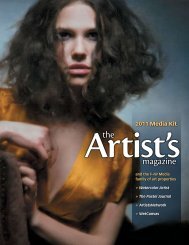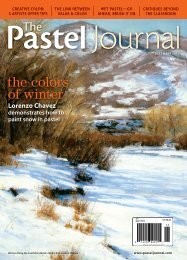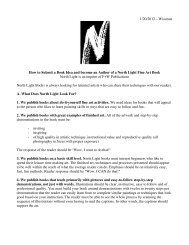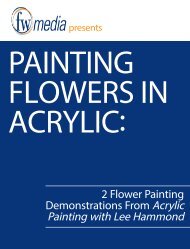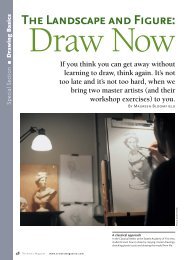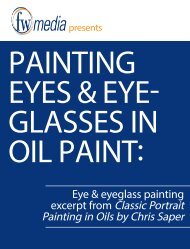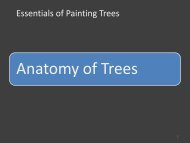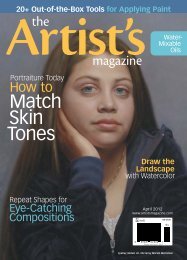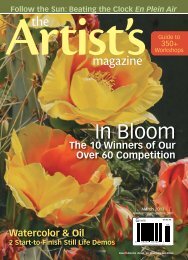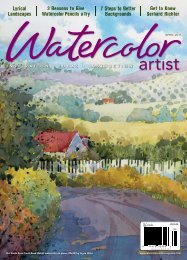The Pastel Journal, February 2011 Sample - Artist's Network
The Pastel Journal, February 2011 Sample - Artist's Network
The Pastel Journal, February 2011 Sample - Artist's Network
- No tags were found...
Create successful ePaper yourself
Turn your PDF publications into a flip-book with our unique Google optimized e-Paper software.
full-time day job—she appreciates being able tostart painting whenever she has a spare minute.<strong>The</strong> location in November Sky is Ballston Beach inTruro, which she describes as an ever-changinglandscape. “<strong>The</strong> Atlantic Ocean batters away at it,and has cut back 15 to 20 feet of dune since thepainting; both houses have since been movedback. I chose the scene because of the unbelievablelight from a late day sun that was on theclouds and just brushing the beach.”She painted the piece on Wallis pastel paperand used primarily Sennelier pastels for the fallbrush and Winsor & Newton pastels for theclouds, which posed the biggest challenge in thepainting. “This was the first painting in whichI strayed into my now standard green andpurple combination for clouds, rather than theblue-grays I’d previously used.”Waiting (above) is a composite location comprisedof a rowboat that rests on the breakwaterat Wellfleet Harbor (a favorite subject for manylocal artists) and a marshy landscape anothertwo miles west. “I thought the boat sitting on thegranite wasn’t so pretty,” Sanders says, “but onthe sand, echoing the colors of the sky, I knewit would be something else. <strong>The</strong> challenge, then,was to keep the lighting consistent and to accuratelycreate the shadow that the boat would castwhen I wasn’t really looking at a shadow.”Waiting (12¼x12)Amy Sanders (www.amyksanders.com) is an award-winning artistand signature member of the <strong>Pastel</strong> Society of America. She hasexhibited in galleries in Connecticut and on Cape Cod. Her workis represented by the Addison Art Gallery of Orleans, Mass.<strong>February</strong> <strong>2011</strong> • www.pasteljournal.com 21
Marsha Hamby SavageSOUTHERN MYSTIQUEGeorgia artist Marsha Hamby Savage has alwaysbeen an admirer of the natural world. “Some ofmy earliest memories,” she says, “are of takingoff my shoes and wading in a creek, pickingup a pretty rock, looking at the moss and runningmy hands over it. <strong>The</strong>re’s something aboutmoss that just makes me want to feel it.”<strong>The</strong> moss is characteristic of a landscapethat is shrouded in green. “<strong>The</strong> South has gentlerolling hills, mountains and pastures coveredwith many shades of green and no relief fromwarmer earth colors,” says Savage. “It seemseverything is tinged with some type of green.Every time I paint en plein air, I’m confrontedwith a different green than I saw the last time; Ican hardly believe there is yet another shade.”<strong>The</strong> respite, of course, occurs in the sky,which, according to the artist, is often tingedwith pink, lavender or yellow where it meetsthe horizon. “Although many times we don’t getto see as much sky,” she points out, “becauseof the abundance of trees. It has an intimatefeeling compared to the vast landscapes of ourmiddle and western states.”For Mossy Creek (below), which depicts ascene in the North Georgia Mountains, theartist used Terry Ludwig pastels, her favorite,on Ampersand <strong>Pastel</strong>bord, a surface whichallows for a watercolor underpainting. Shealso chose this surface—with a watercolorunderpainting—for Shadow and Moss (opposite),a studio pastel based on reference material fromMossy Creek (9x12)22 <strong>The</strong> <strong>Pastel</strong> <strong>Journal</strong> • <strong>February</strong> <strong>2011</strong>
Teri GortmakerCOLOR & CONTRASTColorado artist Teri Gortmaker grew up on hergrandparents’ farm in an area of southeast Texascalled <strong>The</strong> Big Thicket. “My childhood was pineforests, vegetable gardens, flower beds, cows,pigs and hunting dogs,” she says. “<strong>The</strong> landscapewas always changing and miraculous. It seemedthe logical subject matter for me, as an artist,because it was what I was most connected to.”Later, as a transplant to Boulder, Gortmakerfound she was still attracted to the land; andColorado, she says, has attitude. “It’s rugged,bold, diverse and filled with dynamic colorcontrasts—big mountains, fl at gold prairie allthe way to Kansas, and a giant blue sky hangingover it all.” On the subject of that sky, Gortmakeradds: “It just stuns me with its clarity. How cananything real be that color of blue? And what isthat color exactly? It’s always exciting to paintthat blue next to the gold of aspen trees or thestark cold whites of new winter snow.”<strong>The</strong> aspen, mountains, prairie; these subjectscontinue to thrill because they’re never the same.“I often paint my favorite places again and again,”she says, “and it’s different every time. Nature isalways in flux so the possibilities are endless.”Gortmaker’s approach to painting beginswith the organization of shapes and colors intowhat she refers to as “a visual dialogue thatworks.” For larger paintings, she prefers to workin the studio, but she does enjoy working en pleinFeedin’ Time (16x20)24 <strong>The</strong> <strong>Pastel</strong> <strong>Journal</strong> • <strong>February</strong> <strong>2011</strong>
For Balfrey, nothing can matchthe excitement of painting on site,and she tries—as much as possible—to brave the elements. “<strong>The</strong> visualaspect to this type of painting justincreases the quality of the studiowork; we see and remember so much,”she says. “But we do have cold, snowywinters.” So she’s a happy studiopainter as well, appreciating the opportunityit affords for concentratedwork and experimentation.For plein air painting, Balfrey tendsto work small—6x8 or 9x11—andfinds these pieces become indispensableguides for color when working larger. Inthe studio, after working out a compositionusing thumbnails and value studies,she begins with an underpainting onAmpersand <strong>Pastel</strong>bord or Wallis pastelpaper. “I have three methods: one, a thinwatercolor wash; two, thin oil washes;or three, pastel blended into the support,”she says. “From there, I respondto the underpainting, which sometimesgoes in the direction I’d planned and, insome cases, takes on its own direction.I’ve learned to ‘flow’ with the paintingand listen to what it needs.”Balfrey has seen her artistic goalschange over the years, recalling that—as a beginning painter—she justwanted to “get it right.” Initially, shelooked to dramatic contrasts of lightagainst dark to attract the viewer. “NowI’m working towards softening thoseedges and leaving detail out,” she says,“but still getting the viewer to journeythrough my pieces.” Her latest effortsare more lyrical, poetic and rhythmic.“Now I want to create scenes that takethe viewer to another place,” she says.Indeed, that describes an essentialingredient in the work of all four artists;these are paintings that transportus not only into new landscapes butalso into rich emotional territory.Anne Hevener is the editor of <strong>The</strong> <strong>Pastel</strong> <strong>Journal</strong>.Creek’s Melody (14x11)Willo Balfrey (www.willobalfrey.com) is an associate member of the <strong>Pastel</strong>Society of the West Coast, and enjoys signature status in the Northwest <strong>Pastel</strong>Society, the Sierra <strong>Pastel</strong> Society and the <strong>Pastel</strong> Society of Oregon. She hasstudied with painters Albert Handell and Harley Brown, but most influentialhas been the mentorship of Richard McKinley. “ I have been very lucky inmy art journey to find a mentor and friend in Richard,” she says. “I knewI wanted to paint in the style he painted, and by working with him, he hastaken me on his journey and given me wings to fly on my own.”View more pastel landscapes by the artists featured in this article atwww.pasteljournal.com/article/pastel-american-landscape.<strong>February</strong> <strong>2011</strong> • www.pasteljournal.com 27
GOOD STUDY HABITS60 <strong>The</strong> <strong>Pastel</strong> <strong>Journal</strong> • <strong>February</strong> <strong>2011</strong>
Although they may not be the most thrilling part of the creativeprocess, thumbnails are vital, offering both a road map to betterpaintings and a pathway to greater creative freedom.BY MARLA BAGGETTAA THUMBNAIL IS THE THING THAT MOSTartists would like to just skip. When I startedplein air painting, I recall thinking to myself:“I’m a good painter; I don’t need to do a thumbnailsketch. I can just dive into the fi nish; noproblem.” But somewhere along the way, I begana conversion. I asked myself: If investing a bit oftime into this preparatory step will save me timeand frustration in the long run, why wouldn’tI do that? Today, I’m a true believer.Recently, I conducted a workshop and gaveinstructions for the class to spend half of theirpainting time on preparation, making a planor map in the form of a small value study and acolor study. <strong>The</strong>y went kicking and screaminginto the exercise, but they wound up hooked.Some, in fact, were so enamored of the processthat they spent the fi nal day of the workshopdoing nothing but thumbnails.I’ve come to the conclusion that the use ofthumbnails makes my life easier; and I’m all for that.<strong>The</strong> alternative is flying by the seat of my pants andletting luck be an important element of my painting.Sure, I might sometimes get lucky—but notconsistently—and I want to be consistent.vertical or horizontal. Even if the line thumbnail isall you do, you’re at a better starting point than youwould be painting with no plan at all.Value Thumbnail: This study is especiallyimportant in determining whether your picturewill have the dynamics and mood youseek. Break down your composition into thethree to five largest shapes and assign values tothose shapes. <strong>The</strong>n study the arrangement, asking:Does it start to capture the quality of lightand the atmosphere? It’s amazing how much asmall value thumbnail will tell you. You shouldbe able to tell if you’re on the right track andwhether it’s worth moving forward.Color Thumbnail: Admittedly, taking thetime for this additional step isn’t something I doevery time I start a painting. Sometimes it’s funto work directly from the value study and inventthe color. <strong>The</strong>re are times, however, when I feelslightly unsure of my direction and appreciatethe extra information a color study provides.Start the thumbnail by translating the valuesinto flat planes of color using a limited palette;don’t add another color if you can solve theproblem with one already in use. RememberOpposite page,clockwise fromtop left: <strong>The</strong>line thumbnail,value thumbnail,color study andfinal painting,In Between (15x15)Three Study Methods<strong>The</strong>se are the three thumbnailtechniques I use in combinationwith a viewfinder (see “Viewfinder: Your Study Partner” onpage 62) to lay the groundworkfor a finished painting:Line Thumbnail: This is aquick sketch of the major elementsof your subject using a blocked lineto keep the shapes simple. You cansketch out several different proportionalarrangements—square,Marla Baggetta (www.marlabaggettastudio.com) has been aprofessional artist for 25 years with a client list that includes WaltDisney and Houghton Mifflin. A signature member of the <strong>Pastel</strong>Society of America and the <strong>Pastel</strong> Society of Oregon, Baggetta’swork has been widely exhibited in galleries and juried showsand has appeared in art magazines and books, including PureColor: <strong>The</strong> Best of <strong>Pastel</strong> (North Light Books, 2006). She’s representedin Oregon by Riversea Gallery; in Southern Californiaby Galerie Gabrie; and in Chicago by KH Galleries. She teachesworkshops in a variety of locations, making her home in WestLinn, Ore., with her husband Mike Baggetta, also an artist.<strong>February</strong> <strong>2011</strong> • www.pasteljournal.com 61
Additional valueand color studiesfor the painting,In Between, onpage 60)viewfinder: your study partnerViewfinders in avariety of formats(far left), and a valuestudy (left) for thefinal painting So Far(below; 26x18)Thumbnails and viewfinders go hand in hand as powerful tools fordesigning a dynamic composition. By using a viewfinder that dividesthe picture plane into quadrants (see the photo above), you canduplicate those same quadrants, lightly, on your thumbnail andinitial painting sketch, which makes drawing out the elementsin your scene much easier. Whereas I once had problems withsome elements wandering out of my picture, the accuracy of mydrawings greatly improved once I started using this tool.You can make a viewfinder with florist wire, or sandwich a pieceof acetate between two pieces of mat board then use a permanentmarking pen to divide the view into quadrants. Make severalviewfinders that are consistent with the proportions in whichyou typically paint, and you’ll be off and running.To see more studies and paintings by Marla Baggetta, visit our website:www.pasteljournal.com/article/pastel-color-studies.62 <strong>The</strong> <strong>Pastel</strong> <strong>Journal</strong> • <strong>February</strong> <strong>2011</strong>
that this isn’t a miniature painting; it’s a color study,so save the detail for the finished piece.Sticking to the Plan (or Not)Although it sounds counter-intuitive, I’ve foundthat thumbnails can actually make my work morespontaneous. Once I have a foundation for mypainting, I’ve essentially built myself a playground.If I want to change the color or play around withthe value relationships, I can (as seen in the studiesabove). It becomes a more intentional spontaneity—ratherthan an indiscriminate drifting awayfrom my original intention.At times I even find I like my thumbnail betterthan the fi nished painting it inspired, feeling thatthe latter missed the essence of the original sketch.This can be disappointing, but I understand why ithappens: Working on a small study requires lessinvestment—in both time and materials—so it’smuch easier to work more loosely. <strong>The</strong>refore, inorder to hang on to that sense of freedom in youractual painting, I’ve found it helps to limit the time Ispend on it, diminishing the “precious” component.I try to retain the carefree attitude that I took when Icreated the thumbnail and carry that feeling into thefinish. It’s still just a piece of paper, after all.study tips<strong>The</strong> following suggestions may help you maximize yourthumbnail studies:Find the Right Tool. It’s important to find a drawingmedium that feels comfortable for thumbnails. I like to usea plain black ballpoint pen—readily available and superconvenient. I can achieve a full range of value, too, simplyby varying the pressure I apply. I also like the scratchy linesthat occur—marks that I sometimes even emulate in mypastels to build texture. Experiment a bit to figure outwhat medium suits you. It might even be pastel!Start an Archive. Thumbnails are a wonderful placefor creative incubation. A sketchbook full of thumbnailsfrom both field and studio becomes a treasured part ofyour body of work—a ready archive whenever you needa painting idea. I like to do a painting in the studio directlyfrom a value thumbnail in my sketchbook, which allows meto invent color and really play. Some of my favorite pieceswere developed in this way.A Place to Experiment. Each thumbnail on its own isn’tprecious, which encourages the willingness to experiment.Keep scraps of your favorite papers and tape them into yoursketchbook. Slide a sheet of glassine between the pages inwhich you’ve pasted any pastel thumbnails. It may not bepristine, but it adds charm and history to your sketchbook.Sketching From Photos. I sometimes make a group ofthumbnails from photos I’ve taken. I use the iPhoto programon my computer to create a “contact sheet” that displays16 images on one page. Since the images are already small,I can’t be tempted to add too much detail, sticking insteadto the large, strong elements.<strong>The</strong> sketchbook: a ready supply of painting ideas.<strong>February</strong> <strong>2011</strong> • www.pasteljournal.com 63
Did you enjoythis SAMPle?Order the entire issue, available in print ordigital format, at northlightshop.com.Get the bestart instruction all year long!Subscribe to <strong>The</strong> Artist’sMagazine for one yearfor $21—a savings of63% off the newsstand price!As a Bonus, get anothergreat art magazineat a discounted price:• one year of Watercolor Artistfor just $10 more—a savings of72% off the newsstand price!• OR one year of <strong>The</strong> <strong>Pastel</strong> <strong>Journal</strong>for just $16 more—a savingsof 65% off the newsstand price!Subscribe today at http://artpubs.artistsmagazine.com.All media, collageand illustrationwww.artistsmagazine.comWatercolor, acrylic andmixed watermediawww.watercolorartistmagazine.com<strong>Pastel</strong> and pastelmixed mediawww.pasteljournal.com
Ideas. Instruction. Inspiration.<strong>The</strong> Artist’s MagazineWatercolor Artist<strong>The</strong> <strong>Pastel</strong> <strong>Journal</strong>Visit www.artistsnetwork.com/magazines to subscribe to the bestin art instruction magazines.Receive a FREE downloadable issue of <strong>The</strong> Artist’s Magazine when you sign upfor our free newsletter at www.artistsnetwork.com/newsletter_thanksFind these and other best-selling North Light fine artbooks & DVDs at www.northlightshop.comCheck out our great online communities atwww.wetcanvas.com and www.artistsnetwork.com
Top resources for artistsMake money selling your art!ArtistsMarketOnline.com gives you the resources to makeit possible.3 Features over 2,000 listings of where to sell your art– updated weekly3 Track your submissions and manage your contacts3 Advice and inspiration from experts and so much moreJoin us now for as little as $1.67 a month!Where & how to sell what you create.BuildingArt Careersfor Over35 Years!Try it FREE for a week!Visit ArtistsMarketOnline.com for more information.Brought to you by the Publishers of North Light Books & <strong>The</strong> Artist’s MagazineLearn from the best artistswith video workshops in your home!Front row instruction,anytime you want!3 Subscriptions now available by medium3 Over 80 workshops to choose from3 Features a variety of media & skill levels3 Convenient – watch what you want, when you want3 Preview every video free – before you buy3 New videos added every weekDozens of Popular Artists including RichardMcKinley, Lee Hammond, Nancy Reyner, Charles Reidand so many more!Visit www.artistsnetwork.tv for the best art instruction videos.Painting Oil Portraits inWarm Lightwith Chris SaperFrom the Publishers of North Light Booksnorth lightB r i n g i n g A r t t o L i f e




